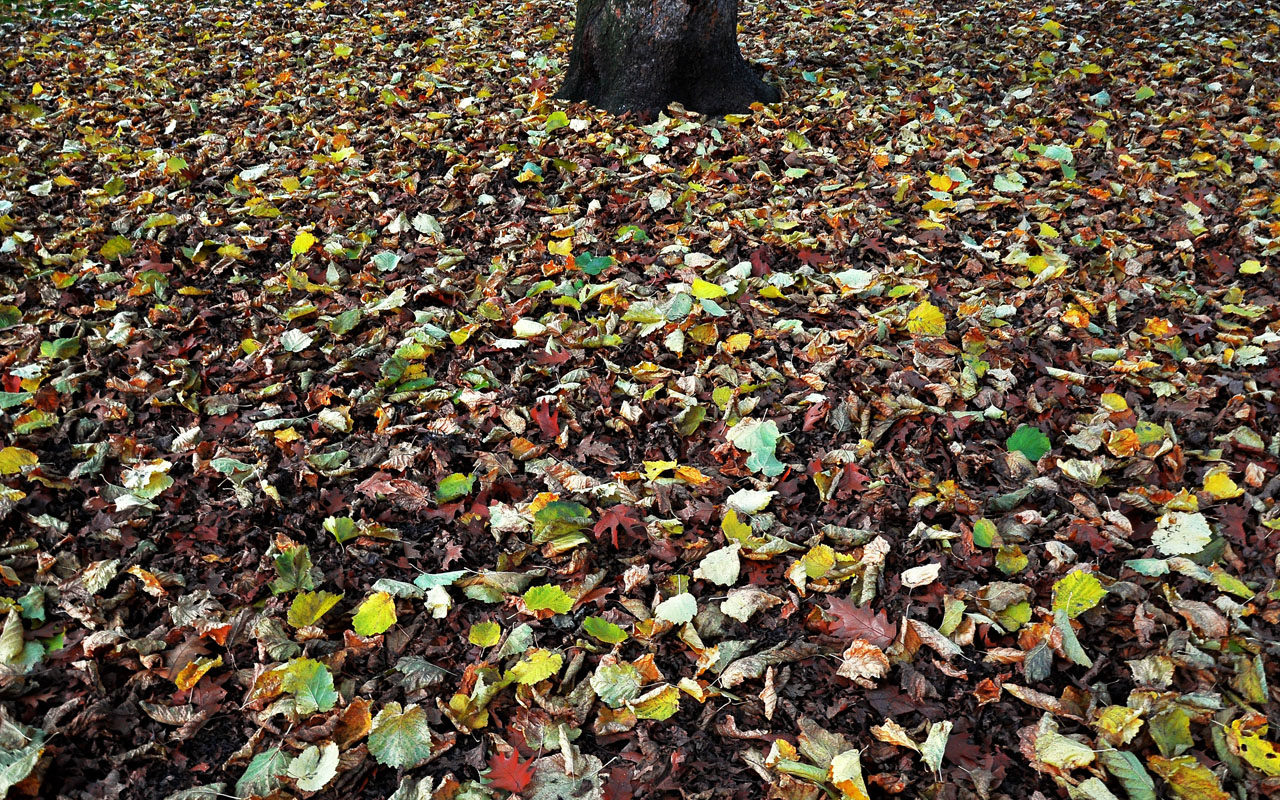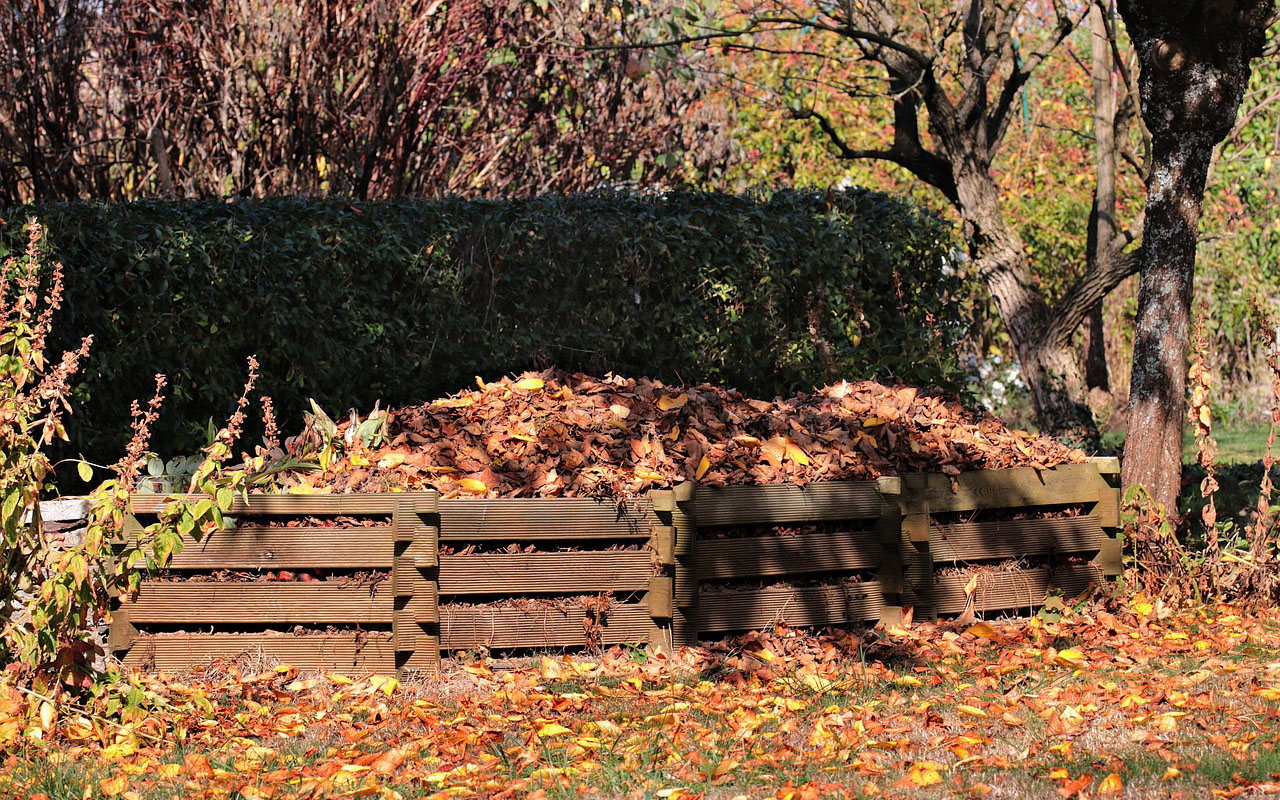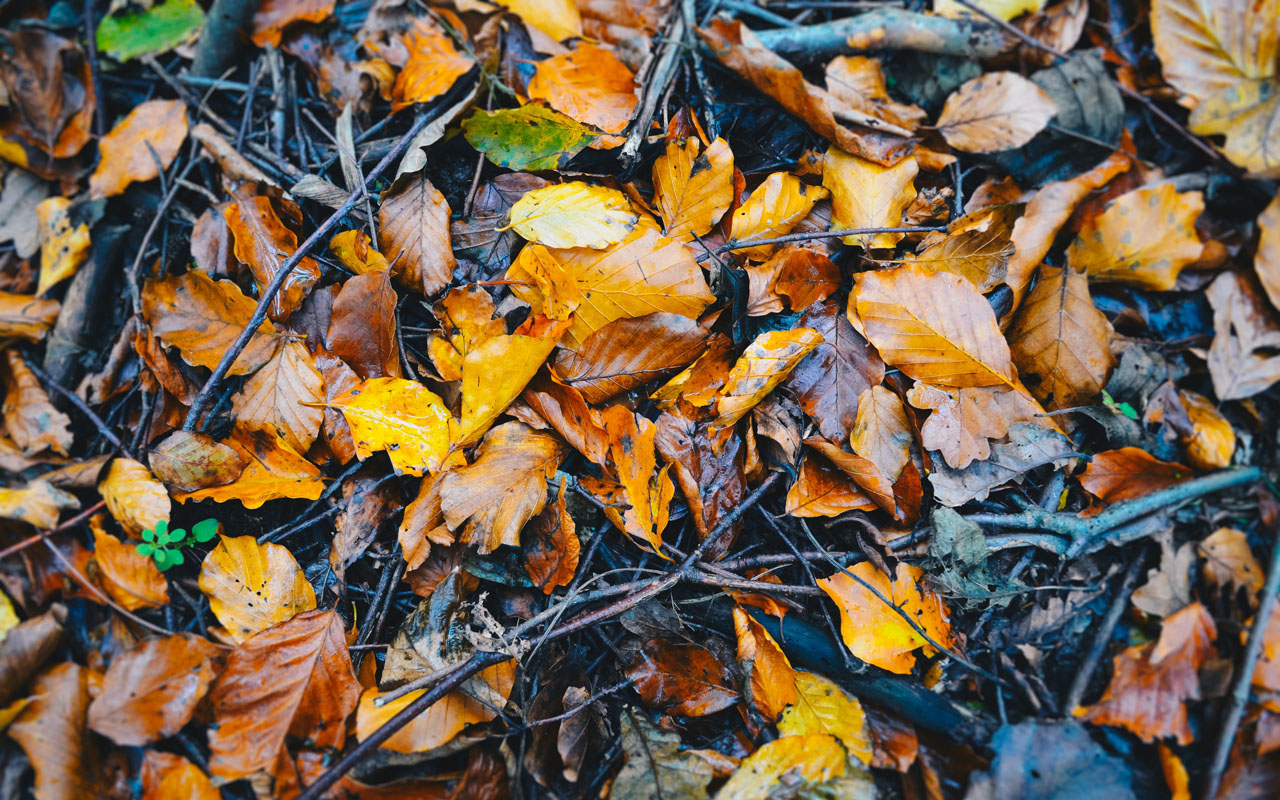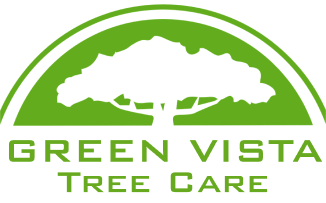Each autumn, as deciduous trees start dropping leaves, are you left wondering what the heck to do with all those fallen leaves? The trees may put on a gorgeous fall color show (see why tree leaves change color in fall), but when your lawn, garden, deck, and driveway are covered in dead leaves, it’s time to do something about it.
Don’t Trash Leaves
Your first impulse may be to toss all your leaves in the trash and send them to the landfill, but there are a few reasons why you shouldn’t.
First, a few facts about landfills/garbage dumps.
- “Green” waste (such as leaves) in covered landfills creates methane, a greenhouse gas.
- In northern Virginia, leaves make up about 20% of what goes into a landfill.
- Landfills are designed to store waste and prevent it from “escaping” into the surrounding environment. Once leaves enter a landfill, they’re there to stay.
- Leaves placed in a landfill are mixed with other trash so they can’t be recycled or reused.

Trees use the nutrients from leaves after they fall
That’s a problem because:
- Leaves, along with other green waste, are uniquely valuable as recycled products or reused in the landscape (for example, as leaf mold or mulch).
- Decayed leaves and garden waste make great compost, which is ideally designed to enrich the soil and provide energy for future tree growth.
It’s Better to Compost & Recycle Leaves
The EPA reports that between 1960 and 2015, the amount of green waste, in tons, that was sent to landfills was cut in half. Instead, municipalities are recovering this material before it hits the landfill. Since 1060, municipal green waste composting has gone from zero tons to over 20 million tons a year. Leaves make up roughly 25% of this, or about 5 million tons annually. In Arlington County alone, 50,000 cubic yards of leaves are collected each year. And that doesn’t even include all the leaves that are composted or used directly by homeowners. This benefits us all.
We recommend one of the following approaches to dispose of fallen leaves:
- Use leaves to make compost
- Turn fallen leaves into leaf mold
- Have them collected and recycled
Why Should I Compost Fallen Leaves?

Composting fall leaves means benefits for your yard and garden
Composting is an efficient and productive way to transform your kitchen and yard green waste from “garbage” into rich, organic compost.
Composting your yard waste mimics the natural cycle of organic material, with beneficial microbes breaking down garden waste and transforming it into a nutrient-packed soil amendment and mulch, sometimes called humus.
This crumbly, dark material will disintegrate further as it bonds to soil molecules and to tree roots in the form of humic acid. This humus, or humic acid, is water-soluble and is taken up by tree roots and used as energy by the tree.
This cycle is repeated every year. It may be helpful to see your fallen leaves as part of the larger, annual cycles of nature, instead of just a chore. This slow-and-steady method of soil enrichment and tree nutrients has been going on since the beginning of trees!
In contrast, modern approaches to feeding plants and trees often use synthesized nutrients in the form of fast-acting fertilizers. These may provide immediate greening, but they do not contribute to the long-term enrichment and health of soils. Plus, they are soon washed away as water moves through the soil.
Naturally made compost is ideal for garden use and provides long-term benefits to your soil and landscape.
Composting is Simple
Composting doesn’t take much effort, space or special equipment. Check to see if you can purchase a low-cost compost bin from your city or county. For example, Arlington County sells the GEOBIN compost bin to residents for the below-retail price of only $20.
Or you can simply place everything in a pile (no bin required). Either option will break down your green waste through heat from decay and microorganism activity.
Done correctly, composting is easy, relatively quick, and does not smell or attract pests. For details, check out this helpful information from the city of Alexandria, VA on how to compost, as well as links to resources about composting and yard waste collection.
Leaf Mold vs Compost
Leaf mold and compost are very similar in that they are both the result of decayed green waste. The difference is that leaf mold is compost made from leaves alone.
To make leaf mold, simply place your fallen leaves in a large pile, water it lightly, and wait for Mother Nature to do her work. By next spring, you should have nice, crumbly leaf mold to use in your garden. It makes a wonderful soil amendment (mix it into the top few inches). It can also be used as a mulch layer to suppress weeds, moderate soil temperature, and retain moisture.
If you’re concerned about leaves blowing around, corral them in a circular pen made from chicken wire, burlap or fencing.
Leaf Pickup for Composting
 If you don’t have room to make a leaf mold pile or place for a compost bin, your leaves can be taken to a facility that recycles leaves.
If you don’t have room to make a leaf mold pile or place for a compost bin, your leaves can be taken to a facility that recycles leaves.
Many cities and towns in northern Virginia compost green waste to make mulch and compost for public landscapes, as well as for residents to use. If your municipality provides curbside pickup for green waste, make use of it. Check with these local sources to find out more:
- Fairfax County, VA leaf collection
- Alexandria, VA leaf collection
- Arlington, VA leaf and yard waste collection
If your locality offers curbside leaf vacuuming, rake your leaves to the curbside for removal. If you leave green waste cans out for pickup and your garden produces more green waste than fits in the can, fill additional paper green-waste bags and leave them alongside your cart for pickup.
TIP: Plastic yard bags may be cheap–or decorated with seasonal designs–but the filled plastic bags cannot be added to compost. Paper green-waste bags can be, as the paper will rapidly and safely decay.
Dealing with Dropped Twigs & Branches in Fall
Falling leaves are sometimes accompanied by falling branches. Trees shed branches naturally, and branches are also damaged by insects, pathogens, and weather, and need to be removed for the health of the tree.

Small twigs and branches can be easily cut into manageable pieces and added to your compost pile, green cart or paper yard waste bags. Here’s why you’ll want to cut those branches:
- Woody branches can tear open green waste bags (those bags aren’t free!)
- Large branches take up more room and prevent you from compacting your green waste down in your cart (meaning it’ll take more leaf collection pickups to clear your yard)
- Larger branches take more time to break down naturally (so if you add them to your compost bin, they’ll still be there next year)
Any fallen branches too large to easily cut up with hand clippers or loppers should be left for professionals to cut with a chainsaw or turn into mulch with a wood chipper. They can also remove this material for you.
The Bottom Line
No matter what the leaf collection process is in your northern VA neighborhood, making compost or leaf mold and adding these to your garden is the most efficient and natural way to improve your soil, the environment, and the health of your trees.
Get helpful tips, local news, inspiring stories, and more delivered right to your inbox every month. Don't miss another issue - join today!





